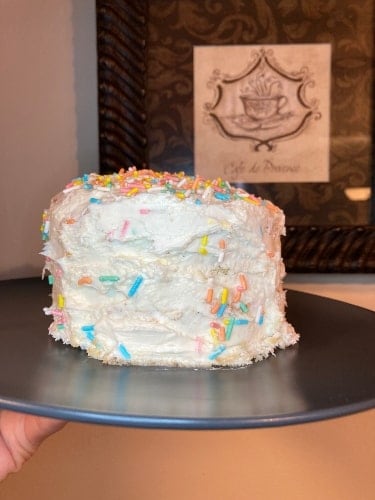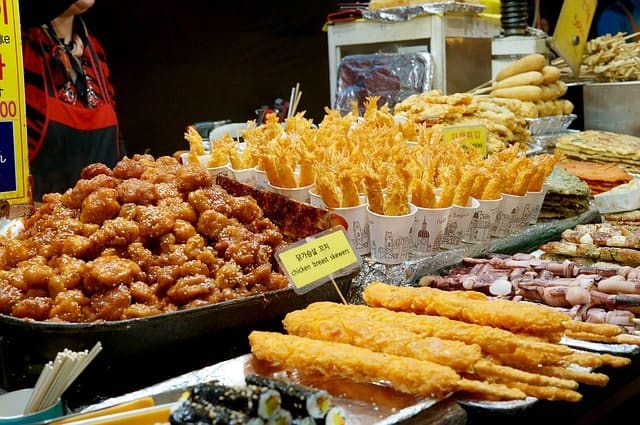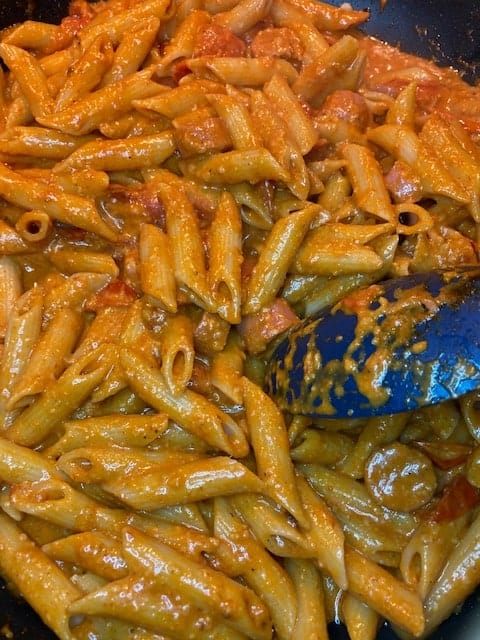Guide to Super Popular and Delicious Korean Rice Balls
Korean rice balls are called Jumeok-bap (주먹밥) in Korean, which literally means fist rice. (Jumeok means fist while bap means rice). It’s possible that this delicious food is called fist rice because the rice is rolled up very tightly into the shape of a ball, also resembling the shape of a person’s fist. Also, what I love about rice balls is that they are very convenient snacks or small meals because you don’t need any utensils to eat them. And, oh my gosh, they’re so delicious, too! However, you’ll have to read further to find out what makes these tasty Korean snacks SO extremely popular!
There are affiliate links in this post. Read my disclosure policy to learn more.
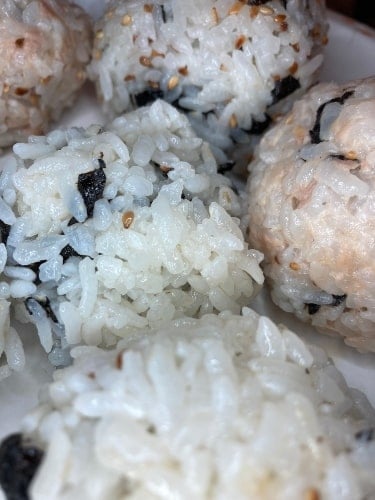
What are Korean Rice Balls?
Korean rice balls are exactly what you may visualize them to be: cooked white rice formed together into the shape of a ball.
As mentioned previously, what makes them so convenient is that you can eat them as a light meal, or as a snack, and you don’t have to use utensils! They’re especially convenient if you want to pack them as a side dish to your portable bagged lunch because you can easily just use your hands to eat them.
Some people may not know this, but Korean sticky rice balls are derived from the famous and very popular Japanese onigiri. (Thus, another name for Korean rice balls is Korean-style onigiri).
In case you are not aware, onigiri is a Japanese food made of plain white rice that is pressed together to form a triangular shape (or a ball) and it’s wrapped in nori (dry edible seaweed sheets).
Japanese rice balls are commonly filled with any of the following ingredients:
- Salted salmon
- Umeboshi (Pickled ume fruits)
- Kombu (Edible kelp)
- Tarako (Plain and salted pollock roe – Alaskan pollock (cod) fish eggs)
- Mentaiko (Marinated pollock roe – Alaskan pollock (cod) fish eggs)
- Katsuobushi (Smoked and fermented skipjack tuna)
- Takanazuke (Pickled takana – it’s basically pickled Japanese mustard green)
However, traditionally, Koreans made their rice balls with these ingredients:
- Plain rice
- Sesame seeds
- Sesame oil
(Many people refer to these as plain rice balls).
Now, the one good thing about sesame seeds is that they are very healthy for you! According to Consumer Reports, sesame seeds provide you with an enormous about of zinc (22-31% of the daily need for zinc). Zinc is super important for your immune system. Sesame seeds also provide 23% of your daily need for iron, too!
Another way to make Korean rice balls is by cooking chopped onion, carrots, and parsley, forming them into cooked plain white rice balls, and adding sesame seeds and sesame oil.
Here’s an example below:
[You’ll really enjoy watching this YouTube video featured on Sweet and Tasty TV. I SURE DID].
*FYI, another super popular way to make rice balls from Korea is to use sesame seeds, sesame oil, pickled daikon, and egg.
**ALSO, my Korean friend recommends pairing rice balls with something spicy, like tteokbokki sauce!!**
FAQs
What are Korean Rice Balls Made Of?
You can make Korean rice balls with several different ingredients depending on what kind of rice ball you choose to make (meaning, what flavor you want). However, as mentioned before, these are the basic ingredients:
- Plain white rice (sushi rice or short-grain rice)
- Sesame oil
- Roasted sesame seeds
- Dried seaweed sheets
What is Onigiri in Korean Culture?
As mentioned previously, we call the Korean version of the Japanese onigiri jumeok-bap (주먹밥). The literal meaning is fist rice. More specifically, jumeok means fist and bap means rice. The most basic kind of jumeok-bap is made with cooked white rice, sesame oil, roasted sesame seeds, and dried seaweed sheets.
How Do You Make Rice Balls Stick Together?
The starch from short-grain rice, sushi rice, or sticky rice makes rice balls stick together. One way to make sure your rice balls will stick together is to form the balls while the rice is still warm. Don’t let it get cold, or it will be harder to form the rice balls.
Also, to ensure that the rice balls are going to be sticky, you can add about four more tablespoons of water to the rice before you cook it.
Which Country Made Rice Balls?
Rice balls are very common in Asian countries. However, rice balls are actually very common, too, in other countries around the world. For example, the following countries make their own versions of rice balls:
- Japan: Onigiri
- Korea: Jumeok-bap
- Italy: Arancini & Suppli
- Ghana: Omo tuo
- China: Tangyuan & Zongzi
Related Articles:
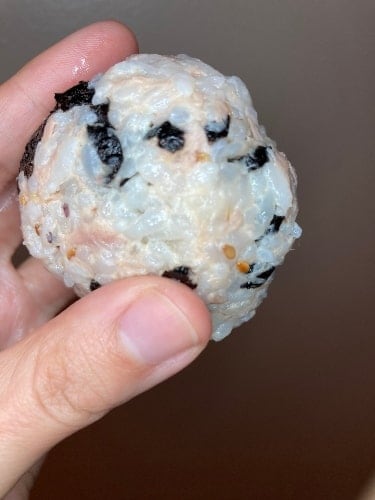
Korean Tuna Rice Balls
Although this is not the traditional way to make rice balls, using tuna has been very popular in recent times.
Keep in mind, in case you decide to make these, most of the Korean rice balls with tuna recipes I’ve found use mayonnaise. (Makes sense, since the mayonnaise probably makes the tuna easier to manipulate into the rice balls).
For example, here’s a Korean tuna rice ball recipe by Jen’s YORI to give you a better understanding of what this is.
Korean Tuna Rice Balls
**FYI, I’ve seen many Korean rice balls with tuna recipe developers recommend canned tuna with oil over canned tuna with water.
Korean Fried Kimchi Rice Balls
One very popular way to make these Korean rice snacks is to make them with fried kimchi rice. YUMMY!
Kimchi, if you’re not already familiar with it, is SUPER important to Korean cuisine.
Basically, it’s a side dish of fermented vegetables (mainly napa cabbage and Korean radish). I’ve gotta warn ya… kimchi is SUPER spicy hot because it’s made with Korean red hot pepper chili paste called Gochujang.
Gochujang is a staple in Korean cooking, just like Salsa Lizano is a major staple in Costa Rican cuisine (you basically use it on everything… well, practically everything).
Luckily, if you don’t have any Korean markets near you, you can sometimes find kimchi in the refrigerated food section of your local grocery store in the “specialty foods” section.
Anyway, I haven’t seen kimchi fried rice at traditional Korean restaurants. However, I have seen and eaten it at more modern Korean (and often Korean-fusion) restaurants.
I’m telling you… it’s so delicious! And I can’t even handle spicy food! I just make sure I have something with me to tame the spiciness (like boba milk tea).
Take a look at the video below so you can see how to make Korean fried kimchi rice balls.
(FYI, this YouTuber on the channel Tastemade adds mozzarella cheese in the center).
Korean Sweet Rice Balls
Ok, so what if you’re craving something sweet? Can you make Korean rice balls desserts? Well, the answer to that is YES!
The Korean sweet rice ball is actually called Gyeongdan (경단) and it’s a type of sweet Korean rice cake that you form into a ball shape. You can coat these Korean sweet rice balls with anything from black sesame powder to cinnamon powder, too.
The good thing about making Korean sweet rice balls is that they’re not very difficult to make!
Take a look at the video below by Ambrosia to learn more. I promise you… it’ll make your mouth water like crazy!
*You may have noticed that this Korean rice balls dessert recipe asks for castella in this video.*
Castella is basically a Japanese sponge cake made mostly of sugar, flour, and eggs. You can find a recipe for it here.
Korean Rice Burger
Another popular trend that has been well-liked for some time now is the Korean rice burger. People call this popular Korean fast food a bap burger (bap means rice in Korean).
Basically, instead of using bread for the bun, you would use flattened plain rice balls.
There are many places around Korea that sell bap burgers and they are especially popular among university students and teenagers. If you’re ever in Korea and you’d like to try an authentic Korean rice burger, you can check out the popular fast food restaurant called BonGousse Rice Burger (봉구스 밥버거/).
Do you like beef bulgogi? [I’m in LOVE with it!]. If so, you should check out this Korean bulgogi rice burger recipe by My Korean Kitchen. Yum!
Final Thoughts on Rice Balls from Korea
These Korean sticky rice treats were so delicious and SUPER DUPER easy to make! I hope this article has influenced your decision to try them for yourself. I’m telling you, they’re so convenient and filling, too. They’re just perfect 🙂
Let me know your thoughts in the comment section below!
